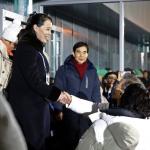Here’s What Kim Really Wants Out of His Meeting With Trump

The dramatic news that North Korean leader Kim Jong Un extended an invitation to President Donald Trump for a summit, and that Trump agreed, is nothing short of a miracle. After a year of hurling threats and insults at each other, as well as provocative military actions that nearly brought the two countries to war, the two leaders will sit down to begin a process of halting North Korea’s nuclear program.
The world has certainly cheered the recent diplomatic progress made between the two Koreas. But much of the response to the groundbreaking news about the Trump-Kim talks has affirmed that Trump’s policy of maximum pressure succeeded in getting North Korea to take seriously Washington’s demands to denuclearize—or face getting a bloody nose.
This is a dangerous rewriting of what it took to bring North Korea to dialogue and what it will take going forward to convince Kim to give up his nuclear weapons.
Let’s face it. Whether called “maximum pressure” or “strategic patience,” the past several U.S. administrations’ policies—aggressive military posturing with threats of decapitation strikes and stringent sanctions strangling North Korea’s economy—have failed to bring the Kim regime to dialogue. Instead, this has only compelled North Korea to develop its nuclear and missile program with ever-greater fervor.
This narrative erases the extraordinarily nimble diplomatic footwork by South Korean President Moon Jae-in. Moon is genuinely committed to a long-term resolution of the Korean conflict, not looking for a short-term diplomatic victory. And that is what gives me great cause for both concern and hope.
To the U.S., steps toward denuclearization have been the starting and ending point for negotiations with North Korea. But for the North Koreans, it has always been about trying to secure a guarantee to merely exist.
Imagine a country that was eviscerated by indiscriminate U.S. bombing campaigns during the Korean War, when more bombs were dropped on North Korea than on all of the Asia-Pacific Theater during World War II. Eighty percent of North Korean cities were totally destroyed, which is why North Korea has developed a paranoid, bomb-shelter mindset. We can blame the North Korean regime for perpetuating it, but we also cannot deny what happened.
Add to that baseline trauma the rapid changes that have occurred on North Korea’s borders, from the collapse of the Soviet Union to a capitalist China that has become South Korea’s largest trading partner, and one can understand why ensuring the sovereignty of his nation would be Kim’s highest priority. North Korea has had to also navigate the wild swings in its relationship with South Korea, from sunshine to darkness. Its siege mentality only heightens during the spring and fall, when the U.S. and South Korea jointly conduct the world’s largest military exercises, involving over 200,000 soldiers, B-2 bombers, and an operational plan rehearsing decapitation strikes on North Korea.
As the U.S. and North Korea drew closer to war, the world pleaded for a true statesman to avert a global nuclear disaster that could impact hundreds of millions. Thankfully, the power of democratic social movements in South Korea ushered Moon into the presidency to fulfill the mandate of his people: to improve inter-Korean relations, which he has so skillfully done with his steadfast commitment to resolving tensions with peaceful gestures and diplomacy.
At Moon’s invitation, hundreds of North Korean officials, athletes, and performers coordinated with hundreds of their counterpart South Koreans for a seamless opening ceremony at the Winter Olympics in PyeongChang. Kim Yo Jong, Kim Jong Un’s sister, became the first member of the Kim dynasty to land on South Korean soil since her grandfather in the Korean War, and she shook hands with Moon at the ceremony.
Without an understanding of the diplomacy that brought North Korea to dialogue or the deeper history of the U.S. role on the Korean peninsula, I fear that the Trump administration will not fully appreciate what it will take to convince North Korea to give up its nuclear weapons. With longtime North Korea envoy Joseph Yun’s recent departure from the State Department, along with the continued lack of a U.S. ambassador to South Korea, the current prospects seem dim.
Yet if there were ever a U.S. president capable of striking an impossible deal, it is Trump. But first, he must educate himself about North Korea’s long-held demand for a peace treaty, or at least nonaggression pact, to replace the 1953 ceasefire with South Korea, which would normalize relations and allow North Korea’s economy to grow and develop. Trump could then not only negotiate the end of the North Korean nuclear threat, but accomplish what U.S. presidents have failed to do for seven decades: establish peace on the Korean peninsula.
Christine Ahn is the founder and international coordinator of Women Cross DMZ, a global movement of women mobilizing for peace on the Korean peninsula.
